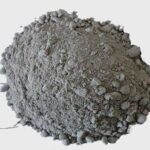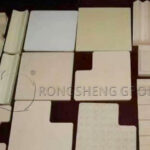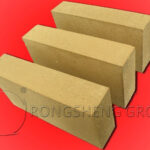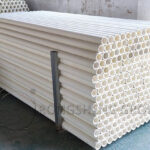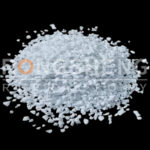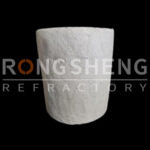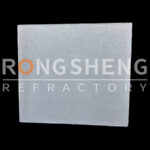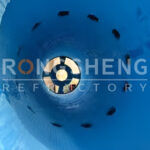Refractory Brick Precast Blocks – Castable Precast Bricks
Refractory brick precast blocks are carefully prepared from refractory aggregates, powders, binders, additives, water, or other liquids, and are cast into unshaped refractory materials with a fixed shape. Monolithic vault for the furnace. According to the binding agent, it is divided into refractory cement bonding, phosphate bonding, water glass bonding, cementless bonding, etc. According to the material, it can be divided into high alumina, corundum, clay, mullite, etc.
Castable precast bricks can be prefabricated into various shapes, also called castable refractory precast shapes. Good thermal shock stability, high strength and good peeling resistance. No seams, good air tightness, less heat loss and energy saving. It can quickly repair the kiln and improve the furnace operation rate. It can realize direct hoisting and mechanized furnace construction, and the construction efficiency is high. Using Monolithic vault for the furnace can solve some technical problems in the furnace-building process for users. Rongsheng refractory material manufacturer can consider lining design and various construction plans for users according to their requirements and furnace type conditions.
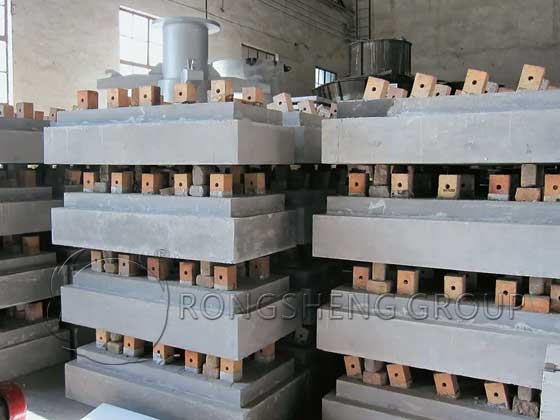
Rongsheng Refractory Brick Precast Block Manufacturer
Rongsheng company has complete products and timely delivery. After-sales service is guaranteed. Castable refractory precast parts are gradually replacing the functions of refractory bricks with their irreplaceable advantages. Under the contemporary green environmental protection initiative, the production technology of refractory bricks is facing severe constraints of low-carbon environment. While the firing process is being updated and improved step by step from raw coal to coal-based gas, and then to natural gas, refractory materials are moving towards burning-free, lightweight, and high-usage production technology. As refractory products serve as high-temperature-resistant lining products in high-temperature industries, they serve the high-temperature parts of kiln linings such as steel, chemical industry, and thermal power. Therefore, continuous improvement and research and development are carried out to cope with the harsh working environment conditions of large furnace linings. This in turn increases the service life of the furnace lining. Its biggest advantage is that it can be pre-baked and directly hoisted, so the construction period is greatly shortened and the quality is stable. In recent years, the proportion of refractory brick precast shapes parts used in some special kiln parts is increasing. Monolithic vault for the furnace. Refractory brick precast parts are divided into small pieces in advance to be constructed in high-temperature kilns, and a special shape is designed. A mold is made according to the shape. The refractory castables and other materials are pre-cast, cured, and baked in the factory before being shipped to the factory. Use after hanging and assembling on site.
The baking of existing refractory brick prefabricated blocks generally adopts a temperature control method. During baking, several temperature measurement points are arranged in the drying kiln and a baking curve is preset. The baking curve includes multiple heating sections and holding sections. By monitoring the temperature of the temperature measurement point, the baking system is carried out according to the preset baking curve. This control method is simple and easy to implement, and is currently the main control method for baking refractory precast parts and even other materials. Refractory brick precast parts are prone to bursting during the baking process. It manifests as the castable suddenly and violently peeling off from its structural surface or exploding into several fragments. Higher or faster baking temperatures cause preforms to burst. In addition to the normal discharge of moisture during baking, due to the higher or faster baking temperature, a negative effect occurs, that is, excessive water vapor pressure causes the preform to burst.
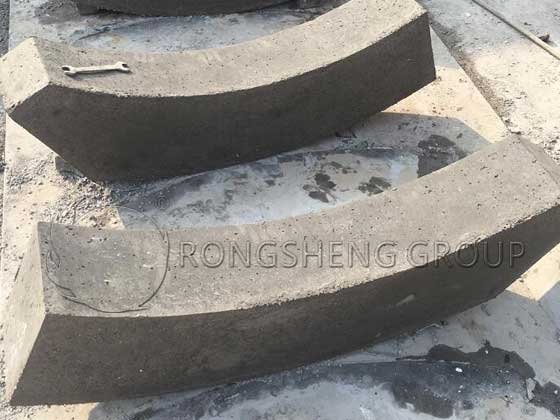
Burn-free Refractory Castable Precast Bricks
The compressive strength of unfired precast refractory bricks after demoulding can reach 55MPa. This is equivalent to the compressive strength of sintered high alumina bricks, which also has a certain degree of elasticity and toughness. The refractory resistance is the same as that of sintered refractory bricks, which can reach 1750°C, and can resist certain corrosion and penetration.
Refractory brick precast blocks can be used directly depending on the material. The creep performance changes as the furnace temperature increases to achieve a tighter use effect. Monolithic vault for the furnace. Castable precast blocks are divided into aluminate cement, water glass, aluminum phosphate, clay bonded and low cement precast blocks according to the binder. According to weight, they are divided into large, medium and small precast blocks. Precast shapes blocks are equipped with steel bars and anchors, so they are divided into ordinary precast shapes blocks, steel bar precast blocks and anchor precast blocks.
Differences between Castable Precast Block Furnace Cover and Refractory Bricks Furnace Cover
The traditional smelting electric furnace cover is made of about 30 kinds of special-shaped bricks and about 2,900 electric furnace top refractory bricks. The construction method using refractory bricks has the disadvantages of high construction difficulty, long construction period, serious deformation, poor thermal stability, and high energy consumption. The traditional high-alumina bricks for electric furnace lids can no longer meet the production application of high-power and ultra-high-power electric furnaces, and have become a “bottleneck” restricting production. Nowadays, cast-type electric furnaces cover precast bricks with high density, strong thermal shock resistance and good corrosion resistance are used as the main raw material. According to the size, thickness and shape of each electric furnace cover, high-aluminum castables are used for the furnace cover. After pouring, curing and baking, they are transported to the site for direct installation and use. Practice has proved that this kind of precast block shape made of refractory castables according to the overall size and shape of the furnace cover is not only easy to install, but also has good integrity, fast and efficient.
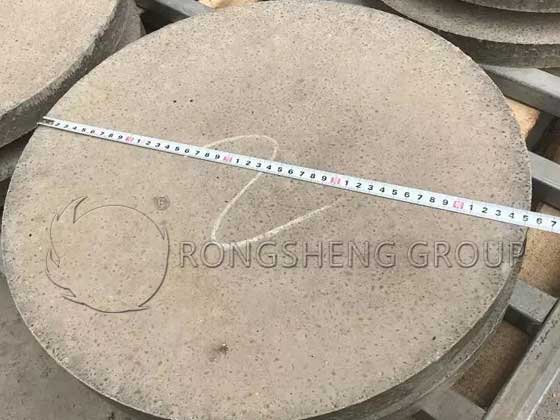
Thermal Stress Distribution of Precast Furnace Cover Block
In the electric furnace production process, the period from the start of power supply to the time when all the charge is melted is called the melting period. During the melting period, more than 3/4 of the charge is melted, and the heat in the furnace can no longer be shielded by the charge. At this time, the arc high-temperature areas in the furnace have been connected into one piece, and the furnace cover is completely exposed to the hot molten metal and is subject to the greatest thermal shock. Most of the damage to the furnace cover and furnace walls occurs at this stage.
There is no direct contact between the furnace cover and the molten metal. At the end of the melting stage, the heat generated by the molten metal is transferred to the inner wall of the furnace lid through radiation. The outer wall is exposed to the air and transfers heat mainly through natural convection heat exchange with the air. Therefore, the thermal analysis temperature load and boundary conditions of the furnace cover mainly involve thermal radiation and convection heat transfer. During the analysis process, the thermal radiation effect on the inner wall of the furnace lid is equivalent to a temperature load of 1750°C, which is applied to the entire inner wall of the furnace lid. For the natural convection between the furnace cover and the air, the temperature of the air is taken to be 25°C, and the convection heat transfer coefficient with the air is set according to the value of l0-3/(ts K). Finally, it can be seen from the thermal analyzer that the temperatures of the refractory brick electric furnace cover and the castable precast electric furnace cover are equivalent. The temperature field changes of the electric furnace cover made of refractory bricks and precast blocks of cast furnace cover are smaller. And the highest temperature is distributed in the part of the inner wall of the furnace cover that is close to the molten metal, and the lowest temperature is distributed in the part where the central cover and the air convection heat exchange.
It can be seen from the thermal analyzer that the maximum thermal stress of the furnace cover is distributed in the center area of the vertical line with the molten metal, at the edge of the wall or the inner wall of the feeding hole, and at the bottom edge of the furnace cover. The minimum stress is distributed on the top of the center cover, and its average thermal stress pressure is about 3.5MPa. Far lower than AL2O3, the material’s yield stress meets the usage requirements. Therefore, the solution of using castable precast block furnace cover is feasible, and can greatly save installation time and reduce labor intensity.
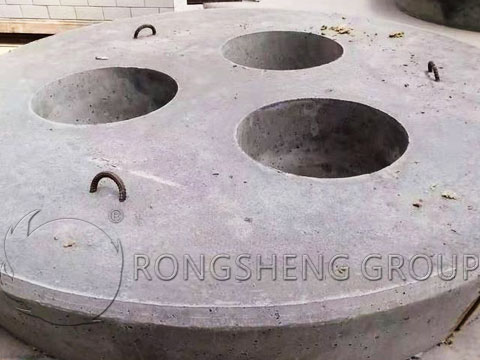
Conclusion on the Use of Precast Shapes Blocks for Furnace Cover
- (1) There is little difference in the thermal stress level when using castable precast block furnace cover and refractory brick masonry furnace cover. But the former saves costs and has high installation efficiency.
- (2) There are several points that need to be paid attention to when making furnace covers made of castable precast blocks. In the current experiment, high-aluminum castables of the same material as high-alumina bricks were used. However, during use, it was found that the furnace cover made of high-aluminum castables is relatively deficient in resistance to corrosion by molten metal and slag splash, thermal shock stability of the furnace cover, and resistance to corrosion by CO in the flue gas.
- (3) The use of castable precast shapes furnace covers in electric furnace production fully demonstrates that under the same thermal stress distribution, the cost of use is lower than that of high alumina bricks. And in future development and applications, high-grade material castables can be used to make electric furnace cover bricks.
Rongsheng Refractory Materials is a refractory material manufacturer with rich production and sales experience. Our refractory products have been sold to more than 100 countries and regions around the world. In the production and use of unshaped refractory castables, we can customize lining material formulas for high-temperature industrial furnaces to effectively solve the problems of refractory linings. At the same time, our refractory precast shapes products also have many customer cases. Contact us to get a free quote and solution for Monolithic vault for the furnace.
